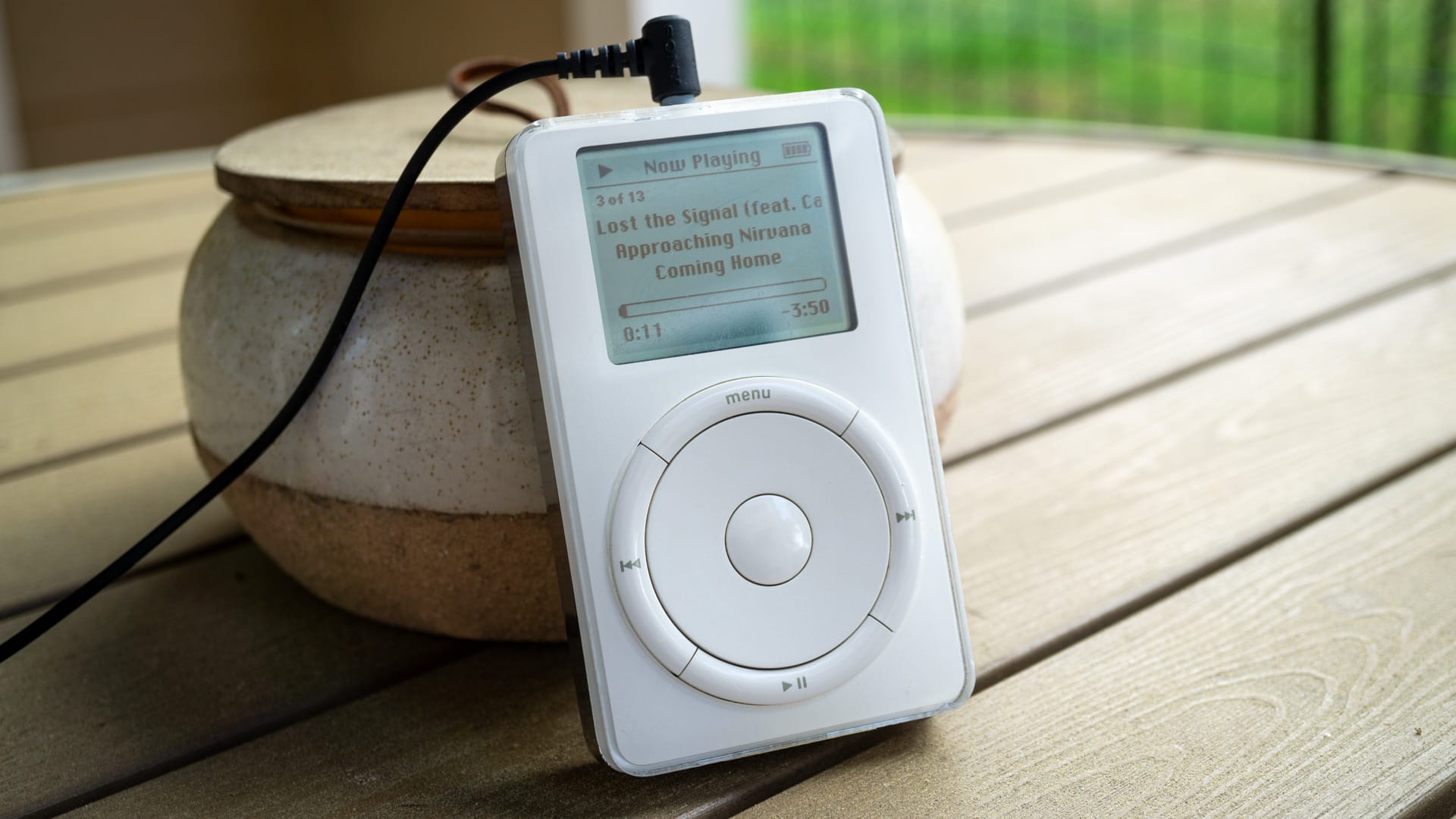The iPod revolutionized portable music listening when it debuted in 2001. Apple’s sleek MP3 player allowed users to carry thousands of songs in their pocket, changing how people consumed music on the go. The iPod’s innovative click wheel interface and integration with iTunes made it incredibly popular, selling over 400 million units across various models.
The device went through several iterations, from the classic hard drive-based model to the compact iPod Nano and tiny iPod Shuffle. Each new version brought improvements in storage capacity, battery life, and features like color screens and video playback.
While smartphones eventually made dedicated MP3 players obsolete, the iPod’s influence on digital music consumption and Apple’s success in consumer electronics is undeniable. Its legacy lives on in the company’s current products like the iPhone and Apple Music streaming service.
Origins and Development
The iPod’s creation marked a pivotal moment in portable music technology. Apple’s innovative device revolutionized how people listened to and interacted with digital music.
Conception and Initial Design
In 2001, Apple sought to enter the digital music player market. Steve Jobs recognized the potential for a device that could store thousands of songs in a compact, portable format. He assembled a team led by Jon Rubinstein to develop the product.
The initial design focused on creating a user-friendly interface and maximizing storage capacity. Apple partnered with Toshiba to secure small hard drives capable of holding vast music libraries.
The team worked intensively to meet Jobs’ demanding specifications for size, battery life, and ease of use.
Technological Innovations
The iPod introduced several key innovations. Its click wheel interface allowed for intuitive navigation through large music libraries. This design became iconic and set the iPod apart from competitors.
Apple developed custom software to manage music efficiently on the device. The integration with iTunes provided a seamless experience for users to organize and sync their music collections.
The iPod’s FireWire connection enabled faster data transfer than USB, allowing quick music uploads.
Product Announcement
Apple unveiled the first iPod on October 23, 2001. Steve Jobs presented it as “a quantum leap in listening to music” during a small media event in Cupertino, California.
The original iPod boasted 5GB storage capacity, enough for 1,000 songs. It featured a 2-inch monochrome LCD screen and 10-hour battery life.
Jobs demonstrated the device’s simplicity, emphasizing its ability to put “1,000 songs in your pocket.” The iPod’s sleek design and white earbuds quickly became cultural icons.
Generations and Models
The iPod evolved through multiple generations and models over its lifespan. Each iteration brought new features, designs, and capabilities to Apple’s iconic music player.
First Generation iPod
The original iPod debuted in October 2001. It featured a 5GB hard drive capable of storing up to 1,000 songs. The device sported a 2-inch monochrome LCD screen and Apple’s innovative Click Wheel for navigation.
Key specs included:
- 10-hour battery life
- FireWire connectivity
- Compatibility with Mac OS 9 and OS X
Apple released a 10GB model in March 2002, doubling the storage capacity. The first iPod established the device’s core functionality and sleek design aesthetic.
Second Generation and Beyond
Apple introduced the second-generation iPod in July 2002. It featured a touch-sensitive scroll wheel, replacing the mechanical version. The lineup expanded to include 10GB and 20GB models.
Subsequent generations brought significant improvements:
- 3rd gen (2003): Thinner design, USB support, 30GB option
- 4th gen (2004): Click Wheel interface, 60GB model
- 5th gen (2005): Video playback, larger color screen
- 6th gen (2007): iPod Classic name, up to 160GB storage
Each iteration refined the iPod’s design and expanded its capabilities, cementing its place as the premier portable music player.
iPod Mini and Nano
The iPod Mini launched in January 2004, introducing a smaller form factor and colorful anodized aluminum casings. It featured a 4GB hard drive and the Click Wheel interface.
Key features:
- 3.6 x 2.0 x 0.5 inches
- 3.7-ounce weight
- 8-hour battery life
The iPod Nano replaced the Mini in September 2005. It utilized flash memory instead of a hard drive, allowing for an even smaller design. The Nano went through several form factors over its lifespan, including:
- Original tall design (1st-2nd gen)
- Short, wide “fatty” design (3rd gen)
- Tall design with video (4th-5th gen)
- Multi-touch screen (6th-7th gen)
iPod Shuffle
Apple introduced the iPod Shuffle in January 2005 as an ultra-compact, flash-based player. The first generation lacked a screen and used a shuffle mode to play songs randomly.
Shuffle iterations:
- 1st gen: USB stick design
- 2nd gen: Clip-on form factor
- 3rd gen: Button-less design with VoiceOver
- 4th gen: Return of physical buttons
The Shuffle appealed to users seeking a simple, lightweight player for workouts and active use.
iPod Touch
The iPod Touch debuted in September 2007, bringing iOS and a multi-touch interface to the iPod line. It essentially functioned as an iPhone without cellular capabilities.
Key features evolved across generations:
- App Store access
- Front and rear cameras
- Retina display
- A-series processors
- Wi-Fi and Bluetooth connectivity
The iPod Touch became Apple’s flagship iPod model, offering a portable computing experience alongside music playback. It saw regular updates until 2019, serving as an entry-level iOS device for many users.
Impact on Music Industry
The iPod revolutionized how people consumed and interacted with music, reshaping the entire music industry landscape. Its influence extended far beyond personal listening habits.
iTunes Integration
iTunes became the central hub for iPod users to manage their music libraries. The software allowed easy organization, purchasing, and syncing of digital music. Apple’s seamless integration of hardware and software created a user-friendly ecosystem.
iTunes introduced the concept of purchasing individual songs for $0.99, challenging the traditional album-centric model. This shift gave consumers more flexibility in building their music collections.
The platform also provided a gateway for independent artists to distribute their music directly to listeners, bypassing traditional record label gatekeepers.
Digital Music Revolution
The iPod accelerated the transition from physical media to digital formats. CD sales declined as consumers embraced the convenience of carrying thousands of songs in their pockets.
Music became more portable and accessible than ever before. Listeners could create custom playlists and shuffle through their entire libraries with ease.
The device’s popularity sparked a surge in digital music sales. By 2010, digital music purchases surpassed physical CD sales in many markets.
Music Distribution and Piracy
iPod’s rise coincided with increased concerns about music piracy. The ease of transferring digital files led to widespread file-sharing through platforms like Napster.
To combat piracy, the music industry explored new digital distribution models. Subscription-based streaming services emerged as a response to changing consumer habits.
Apple’s iTunes Store provided a legal alternative for purchasing digital music. It helped establish a new revenue stream for artists and record labels in the digital age.
The iPod’s success also influenced how artists released and promoted their music, with some experimenting with digital-only releases and exclusive content for iPod users.
Cultural and Social Influence
The iPod revolutionized how people consumed music and shaped popular culture in the early 2000s. Its sleek design and innovative features transformed personal audio and influenced lifestyle trends.
Lifestyle and Branding
The iPod became a status symbol and fashion accessory. Its iconic white earbuds signaled coolness and tech-savviness. Apple’s minimalist design aesthetic extended beyond the device, influencing product design across industries.
The iPod’s portability allowed users to carry their entire music libraries, changing how people interacted with music in daily life. It became common to see people with earbuds in public spaces, creating personal soundtracks for various activities.
Advertising Campaigns
Apple’s iPod advertisements were pivotal in establishing the product’s cultural significance. The silhouette campaign, featuring dancing figures with white iPods and earbuds against colorful backgrounds, became instantly recognizable.
These ads emphasized the joy of music and positioned the iPod as a fun, energetic product. The campaign’s success helped Apple reach a broader audience beyond its traditional computer market.
Television commercials often featured popular songs, further cementing the iPod’s association with contemporary music culture.
Celebrity Endorsements
Apple leveraged celebrity power to promote the iPod. Musicians like U2 and John Mayer appeared in iPod commercials, lending star power and credibility to the brand.
Special edition iPods, such as the U2 iPod, featured engraved signatures and pre-loaded content from popular artists. These collaborations helped position the iPod as an essential tool for music lovers and creators alike.
Celebrity sightings with iPods generated media buzz and reinforced the device’s cool factor. Paparazzi photos of stars using iPods served as unofficial endorsements, further popularizing the product among fans.
Technological Evolution
The iPod underwent significant technological advancements throughout its lifespan. These improvements transformed the device’s interface, storage capacity, and overall performance.
From Mechanical to Touch Interfaces
The iPod’s control interface evolved dramatically over time. Early models featured a mechanical click wheel, allowing users to navigate menus and select songs by physically rotating the wheel. This intuitive design became iconic for the iPod line.
In 2007, Apple introduced the iPod Touch. This model replaced the click wheel with a multi-touch display, similar to the iPhone. The touch interface enabled more complex interactions and expanded the device’s capabilities beyond music playback.
Later iterations of the iPod Nano also adopted touch screens, further streamlining the user experience across the product line.
Storage Capacity Increases
iPod storage capacity grew exponentially with each new generation. The first iPod, released in 2001, offered 5GB of storage – enough for about 1,000 songs.
By 2007, the iPod Classic boasted up to 160GB of storage, capable of holding 40,000 songs. This massive increase allowed users to carry their entire music libraries in their pockets.
The transition from hard disk drives to flash storage in later models improved durability and reduced power consumption, though at the cost of some storage capacity.
Battery Life and Durability
Apple consistently improved the iPod’s battery life and durability. Early models offered around 10 hours of playback time, while later versions could last up to 40 hours on a single charge.
The shift to solid-state storage in the iPod Touch and Nano lines enhanced shock resistance. These models could better withstand drops and impacts compared to their hard drive-based predecessors.
Water resistance was introduced in later iPod Shuffle models, making them suitable for use during workouts or in rainy conditions.
Competition and Market Dynamics
Apple’s iPod faced fierce competition and evolving market forces throughout its lifespan. The device’s dominance was challenged by rival MP3 players, smartphones, and streaming services.
Competing MP3 Players
Several companies launched MP3 players to compete with the iPod. Microsoft introduced the Zune in 2006, offering features like Wi-Fi sharing and a subscription-based music service. Creative’s Zen series and SanDisk’s Sansa line provided alternatives with expandable storage and radio functionality.
Sony’s Network Walkman aimed to leverage its strong brand recognition in portable audio. These competitors often offered lower prices or additional features to differentiate themselves from the iPod.
Despite these efforts, Apple maintained its market leadership through superior marketing, sleek design, and tight integration with iTunes.
Rise of Smartphones
The introduction of the iPhone in 2007 marked a significant shift in the portable media player landscape. Smartphones began incorporating music playback capabilities, reducing the need for separate devices.
Apple’s own iPhone cannibalized iPod sales as consumers opted for multi-functional devices. Android smartphones further expanded the market, offering diverse options for mobile music consumption.
This trend led to a decline in dedicated MP3 player sales, including the iPod. Apple responded by emphasizing the iPod Touch, which offered similar features to the iPhone without cellular capabilities.
Streaming Services Era
The emergence of music streaming services fundamentally changed how people consumed music. Spotify, launched in 2008, pioneered the subscription-based streaming model.
Apple entered the streaming market in 2015 with Apple Music, acknowledging the shift away from downloaded content. This move signaled a transition from the iPod-centric iTunes ecosystem to cloud-based music libraries.
Streaming services reduced the need for large-capacity music players, further impacting iPod sales. The convenience of accessing vast music libraries without local storage became increasingly appealing to consumers.
Legacy and Discontinuation
The iPod’s impact on portable music and Apple’s success was profound, but its dominance eventually waned as smartphones took over. This section explores the final iPod models, changing consumer preferences, and the device’s ultimate discontinuation.
Last Models
Apple released the 7th generation iPod Touch in May 2019. It featured an A10 Fusion chip, up to 256GB of storage, and a 4-inch Retina display. This model retained the classic iPod design while incorporating modern internals.
The iPod Nano and iPod Shuffle saw their final iterations in 2015. These compact models offered 16GB and 2GB of storage respectively, catering to fitness enthusiasts and budget-conscious consumers.
Shifting Consumer Preferences
Smartphones began to dominate the portable device market in the late 2000s. The iPhone, introduced in 2007, combined iPod functionality with cellular capabilities and internet access.
Music streaming services like Spotify and Apple Music gained popularity, reducing the need for dedicated music players. Cloud storage and high-speed mobile networks made it easier to access vast music libraries without local storage.
Consumers increasingly preferred all-in-one devices, leading to a decline in iPod sales. By 2014, iPod revenue accounted for only 1% of Apple’s total revenue, down from 40% at its peak in 2006.
End of an Era
Apple discontinued the iPod Nano and iPod Shuffle in July 2017. This move signaled the company’s shift away from dedicated music players.
The iPod Touch remained in production until May 2022, when Apple announced its discontinuation. This marked the official end of the iPod line after nearly 21 years.
Apple cited the integration of music features across its product lineup as a reason for the iPod’s discontinuation. The company encouraged users to explore music experiences on other Apple devices like iPhones, iPads, and Apple Watches.
The iPod’s legacy lives on in Apple’s current products and services. Its influence can be seen in the design of iOS devices and the development of Apple Music.
References
- Apple Newsroom (2001) – Apple Introduces iPod Link
- Wired – The Creation of the iPod: Interview with Tony Fadell Link
- Rolling Stone – How the iPod Changed Music Forever Link
- MacRumors – A Complete History of iPod Models Link
- The Guardian – How the iPod Changed the World of Music Link
- TechCrunch – Why Apple Killed the iPod Link




